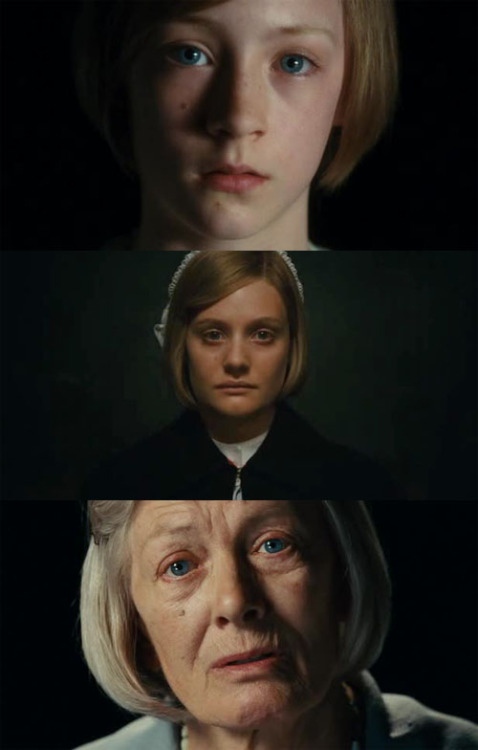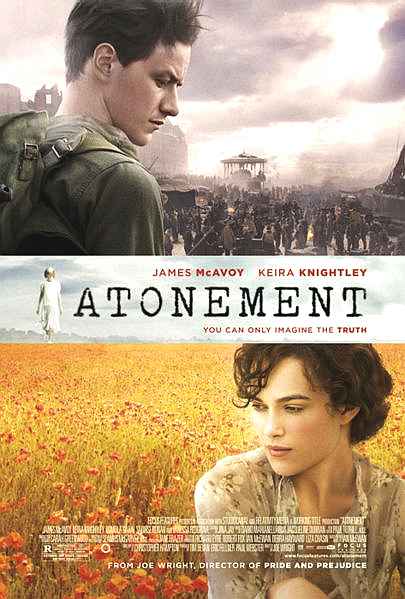In an interview with the Los Angeles Times, costume designer, Jacqueline Durran, talks about the unique challenges which she faced when researching and creating the costumes for the film. Durran explains that Director Joe Wright made it clear to her that he wasn't looking for the average re-creation of the fashions of the day. Durran explains that, "Joe was clear that he didn't want it to look pristine or to have the patina and age you usually associate with that era. When you look at photos of upper-middle-class British families from the '30s, they look rather scruffy, clumpy and lumpy. That's real, but it's not what we wanted because the film isn't based on reality. It's more of a dream, a remembered past, a child's distant memory of a perfect day before everything went horribly wrong."
 Durran explains that one of the biggest challenges was to create the costumes for the 30's period, since there was no original historical clothing which suited her needs. Durran said that they used traditional shapes from the era, but utilized all modern fabrics. This was very time consuming for Durran since she had to dye many different pieces of fabric to create the patterns they needed. Durran gives some background on Cecilia Tallis' striking green dress, and the effort which went into its creation. She explains that they had originally started with three different shades of green, and that in the end they had to dye white fabric with a combination of all three shades in order to come out with the final colour. Durran also reveals that the main goal for the dress was for it to be almost "weightless" in a sense. She wanted it to flow, and blow with the wind, and she wanted it to capture the heat of the day, but also the heat of the moment (in the library.) Durran notes that in the novel McEwan describes the garment as almost a character itself, stating that it is partly responsible for igniting the passion between Cecilia and Robbie, and as such, Durran felt it cruical that " instead of being constructed around Keira's body, that the dress skimmed her [frame] and added to a feeling of semi-nakedness."
Durran explains that one of the biggest challenges was to create the costumes for the 30's period, since there was no original historical clothing which suited her needs. Durran said that they used traditional shapes from the era, but utilized all modern fabrics. This was very time consuming for Durran since she had to dye many different pieces of fabric to create the patterns they needed. Durran gives some background on Cecilia Tallis' striking green dress, and the effort which went into its creation. She explains that they had originally started with three different shades of green, and that in the end they had to dye white fabric with a combination of all three shades in order to come out with the final colour. Durran also reveals that the main goal for the dress was for it to be almost "weightless" in a sense. She wanted it to flow, and blow with the wind, and she wanted it to capture the heat of the day, but also the heat of the moment (in the library.) Durran notes that in the novel McEwan describes the garment as almost a character itself, stating that it is partly responsible for igniting the passion between Cecilia and Robbie, and as such, Durran felt it cruical that " instead of being constructed around Keira's body, that the dress skimmed her [frame] and added to a feeling of semi-nakedness."When asked about the many variations of military uniforms which can be seen in the film, Durran explains that she consulted military uniform advisors for her inspiration. Regarding the advisors, Durran says that "they are a breed all to themselves, and know everything about every rank's uniform." Durran goes on to explain that the uniforms were also very challenging to recreate, as there are not many original garments which remain, and they had to have enough uniforms for over one thousand soldiers. Durran was able to find about two-hundred-fifty original uniforms in correct colour and style, but says that unfortunately they had to compromise on the other seven-hundred-fifty uniforms. She ended up having the original reproduced in Poland, to create the remaining garments.
Durran also briefly mentions the nurse's uniforms, and explains that they were also somewhat difficult to create. She explains that they were looking for a white and blue striped fabric, but could not find anything that was not cotton or polyester. So to be true to the times, Durran had to have all of the linen and fabric woven for the uniforms. The original design for the nurse's uniforms apparently was developed from one of of Florence Nightengale's books on nursing, which would ensure accuracy, considering the fact that there are several references to Nightengale's nursing techniques in the novel itself.
All in all it is very clear that a great deal of effort has gone into the creation of the costumes for the film. Whether its a particular time period or even a particular fabric, Durran and the rest of the crew are clearly dedicated to ensuring that even the smallest and least noticeable details are also perfect and completely accurate. Though descriptions of all of the clothing, is not readily available in the novel, I believe that most readers would agree that Wright, Durran and the crew did well to bring the costumes to life, and give them a feel which just seems to fit so perfectly into the story.
Further Connections:

















